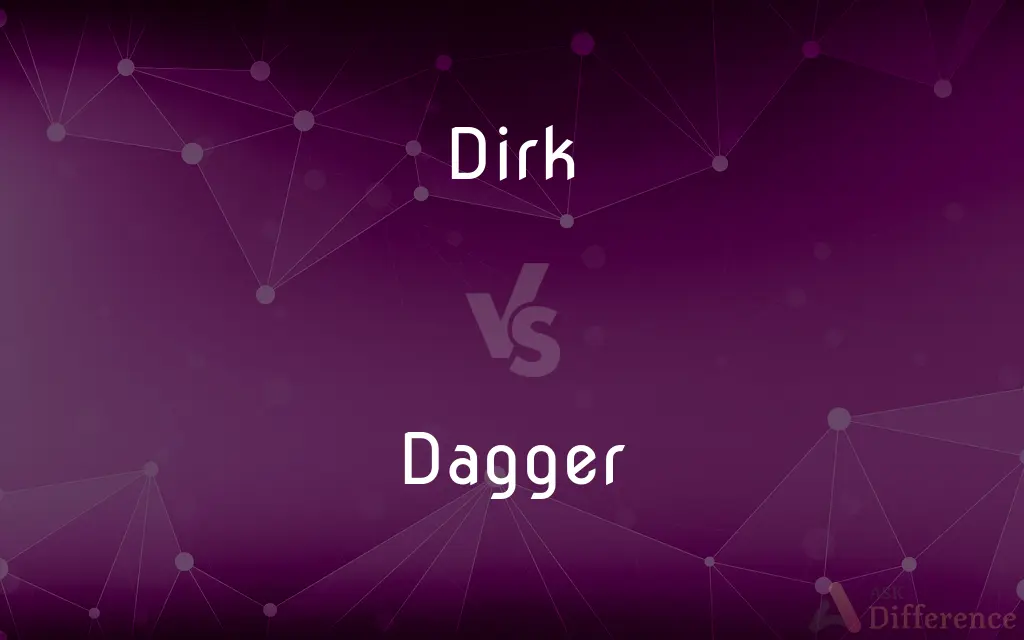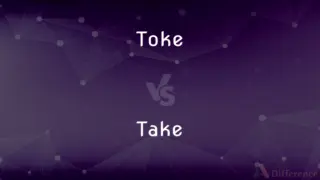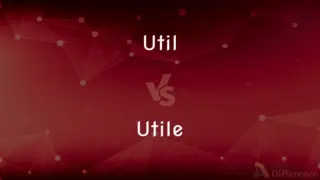Dirk vs. Dagger — What's the Difference?
By Maham Liaqat & Fiza Rafique — Updated on April 28, 2024
Dirk is a long thrusting dagger historically used by Scottish Highlanders, while a dagger is a short knife with a pointed and edged blade, used for stabbing.

Difference Between Dirk and Dagger
Table of Contents
ADVERTISEMENT
Key Differences
A dirk is specifically designed as a long, straight stabbing weapon, often with a blade of around 12 inches or more, traditionally associated with Scottish Highland attire. Whereas, daggers encompass a wider variety of styles and lengths, generally characterized by double-edged blades used for thrusting and stabbing.
The dirk, as part of traditional Scottish Highland dress, serves not only as a weapon but also as a symbol of personal honor. On the other hand, daggers have been utilized across multiple cultures and periods primarily as practical weapons in close combat situations.
Dirks often feature elaborate handles and are sometimes adorned with precious metals and stones, emphasizing their role as a status symbol and part of ceremonial attire. In contrast, daggers are more likely to be designed purely for functionality, focusing on balance and sharpness without extensive decoration.
The dirk evolved from the medieval ballock dagger, gaining prominence in the Scottish Highlands during the 16th and 17th centuries. Daggers, however, have been in use since ancient times, found in various forms across different civilizations, from the Roman pugio to the Indian katar.
In modern times, the use of dirks has largely been ceremonial, especially within Scottish regiments and at traditional events. Daggers continue to see practical use, including in modern military applications, self-defense, and even in some sports like fencing.
ADVERTISEMENT
Comparison Chart
Length
Typically longer, around 12 inches or more
Shorter, varying lengths usually under 12 inches
Edge
Single-edged
Often double-edged
Usage
Ceremonial, symbolic, historical in Scotland
Practical, military, self-defense
Cultural Association
Strongly associated with Scottish Highlanders
Used globally across various cultures
Design
Elaborate, often with decorative handles
Functional, focus on practical design
Compare with Definitions
Dirk
A symbol of personal honor in Scottish culture.
Presenting a dirk as a gift is considered a sign of respect.
Dagger
A weapon used for stabbing or thrusting.
During the duel, he deftly maneuvered his dagger.
Dirk
A long thrusting dagger of Scottish origin.
He wore a traditional dirk in his sock during the parade.
Dagger
Often included in ceremonial or symbolic contexts.
The ritual involved placing a dagger on the altar.
Dirk
A part of military regalia in Scotland.
The officer's dirk was prominently displayed at the ceremony.
Dagger
A short knife with a pointed, typically double-edged blade.
The assassin concealed a small dagger in his cloak.
Dirk
A weapon used historically by Scottish Highlanders.
The museum's exhibit includes a dirk from the 17th century.
Dagger
Common in various historical periods and cultures.
Daggers from the Roman era are prized by collectors.
Dirk
A ceremonial item in Scottish attire.
His dirk was adorned with jewels and intricate engravings.
Dagger
Featured in sports and self-defense.
She practiced with a blunt dagger for her fencing class.
Dirk
A dirk is a long bladed thrusting dagger. Historically, it was a personal weapon of officers engaged in naval hand-to-hand combat during the Age of Sail as well as the personal sidearm of Highlanders.
Dagger
A dagger is a knife with a very sharp point and usually two sharp edges, typically designed or capable of being used as a thrusting or stabbing weapon. Daggers have been used throughout human history for close combat confrontations, and many cultures have used adorned daggers in ritual and ceremonial contexts.
Dirk
A dagger.
Dagger
A short knife with a pointed and edged blade, used as a weapon
He drew his dagger and stabbed the leader
Dirk
To stab with a dirk.
Dagger
A moth with a dark dagger-shaped marking on the forewing.
Dirk
A long Scottish dagger with a straight blade.
Dagger
A short pointed weapon with sharp edges.
Dirk
A penis; dork.
Dagger
Something that agonizes, torments, or wounds.
Dirk
A socially unacceptable person; an oddball.
Dagger
See obelisk.
Dirk
To stab with a dirk.
Dagger
A double dagger.
Dirk
(obsolete) To darken.
Dagger
(weapons) A stabbing weapon, similar to a sword but with a short, double-edged blade.
Dirk
A kind of dagger or poniard; - formerly much used by the Scottish Highlander.
Dagger
(typography) The text character †; the obelus.
Dirk
To stab with a dirk.
Dagger
A point scored near the end of the game (clutch time) to take or increase the scorer's team lead, so that they are likely to win.
Curry's last-minute 3-point dagger silenced the criticism for his so-called failure to come up big in big moments.
Dirk
To darken.
Dagger
A timber placed diagonally in a ship's frame.
Dirk
Dark.
Dagger
To pierce with a dagger; to stab.
Dirk
A long dagger with a straight blade
Dagger
A short weapon used for stabbing. This is the general term: cf. Poniard, Stiletto, Bowie knife, Dirk, Misericorde, Anlace.
Dagger
A mark of reference in the form of a dagger [
Dagger
A timber placed diagonally in a ship's frame.
Dagger
To pierce with a dagger; to stab.
Dagger
A short knife with a pointed blade used for piercing or stabbing
Dagger
A character used in printing to indicate a cross reference or footnote
Common Curiosities
What is a dirk?
A dirk is a long, straight stabbing dagger, traditionally used by Scottish Highlanders.
What is the cultural significance of a dirk in Scotland?
Dirks hold a place of honor in Scottish culture, symbolizing personal integrity and national heritage.
Can a dirk be used as a regular weapon?
Historically, dirks were used as weapons but are now mostly ceremonial.
Are daggers legal to carry?
The legality of carrying daggers varies by country and region, often restricted or regulated.
Are dirks still made today?
Yes, dirks are still produced, mainly for ceremonial purposes and collectors.
How is a dagger different from a dirk?
A dagger typically has a shorter, often double-edged blade designed for stabbing, while a dirk is longer and usually single-edged.
What are the common uses of a dagger today?
Daggers are used for self-defense, military purposes, and in some sports.
What should I look for in a functional dagger?
Look for a well-balanced, sturdy blade and a handle that provides a good grip.
What materials are dirks typically made from?
Traditional dirks are made from steel with handles of wood, often decorated with metal and stones.
Is there a difference in the crafting techniques of dirks and daggers?
Yes, crafting techniques may vary, especially given the more elaborate design typical of ceremonial dirks.
Where would I see a dirk used today?
Dirks are often seen at Scottish weddings, military parades, and cultural celebrations.
How do I care for a dagger to ensure its longevity?
Regular maintenance includes cleaning the blade and oiling it to prevent rust.
Can a dagger be a collectible item?
Absolutely, many daggers have historical significance or unique designs, making them highly collectible.
What is an example of a ceremonial use of a dagger?
In some cultures, daggers are used in rituals or as symbolic gifts during ceremonies.
What is the historical origin of the dagger?
Daggers have been used since ancient times, with designs varying widely across different cultures.
Share Your Discovery

Previous Comparison
Toke vs. Take
Next Comparison
Util vs. UtileAuthor Spotlight
Written by
Maham LiaqatCo-written by
Fiza RafiqueFiza Rafique is a skilled content writer at AskDifference.com, where she meticulously refines and enhances written pieces. Drawing from her vast editorial expertise, Fiza ensures clarity, accuracy, and precision in every article. Passionate about language, she continually seeks to elevate the quality of content for readers worldwide.














































